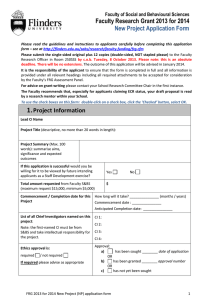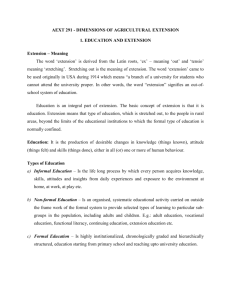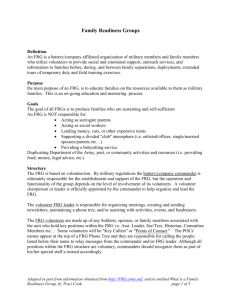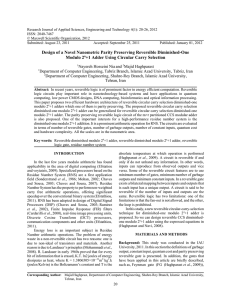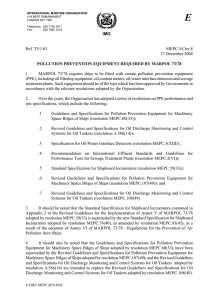Addressing Rural Women’s Needs: Gender Focused Technology
advertisement
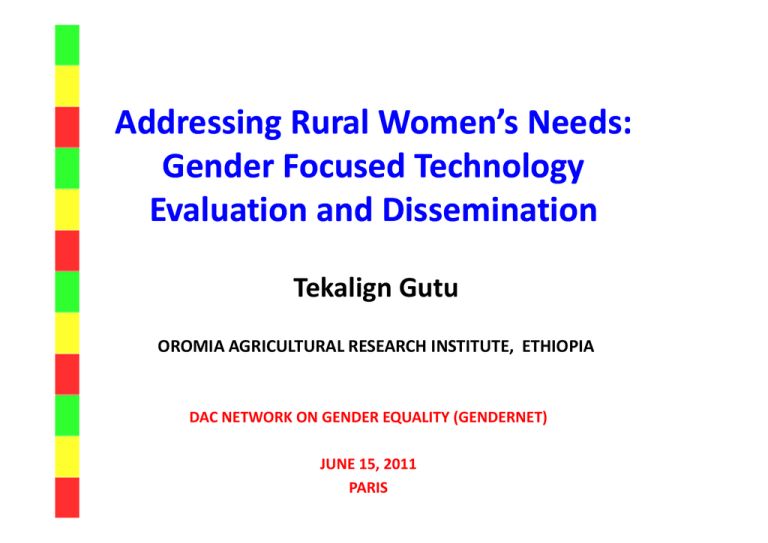
Addressing Rural Women’s Needs: Gender Focused Technology Evaluation and Dissemination Tekalign Gutu OROMIA AGRICULTURAL RESEARCH INSTITUTE, ETHIOPIA DAC NETWORK ON GENDER EQUALITY (GENDERNET) JUNE 15, 2011 PARIS 1. Introduction • Agricultural sector supports 80% of the population and contributes 50% of GDP in Ethiopia. • Rural women play an important role in agriculture but women’s needs and voice tend not to be reflected in research and extension. • Gender mainstreaming in research and extension is important for efficient use of resources and sustainable development. 2. FRG project • FRG is a participatory research approach • Implemented by: Ethiopian Institute of Agricultural Research, Oromia Agricultural Research Institute & JICA • Purpose: To establish FRG approach as one of the core methods of research and extension in Agricultural Research System in Ethiopia. FRG project... • Duration: 2004-2009 (Phase 2 : 2010-2015) • During the phase 1: – 40 research projects – 2 research centers – 52 researchers – 105 extension agents – 89 farmer groups1433 farmers [618 males, 815 females] from 930 households Gender consideration in FRG Gender equality: a core principle for technology development/ improvement • Gender sensitization through gender workshops • Gender mainstreaming in every research project • Both husbands and wives as FRG members in all process of technology development/ improvement FRG project site Phase 1: (2004-2009) 2 research centers in the Central Rift Valley Phase 2 (2010-2015) All the agricultural research institutions (80) in the country 3. Framework of FRG 1st Stage: Development of appropriate technologies 2nd Stage: Verification and Dissemination of the technologies •Crop •Livestock •Agro forestry •Water management •Labour saving etc •ABCoDI sub-project •Other research- extension projects Partners 4. ABCoDI sub-project Abdi Boru Community Development Initiative (ABCoDI): Hope for Tomorrow Women’s working conditions ABCoDI sub-project... • It was a sub-project of FRG to identify and disseminate appropriate technologies which meet rural women’s needs. • The sub-project also intended to verify the premise that promoting both scientific and indigenous knowledge of rural women further facilitates livelihood improvement in the community. 5. Outline of the ABCoDI • Purpose: To evaluate and disseminate appropriate technologies to promote women’s empowerment and livelihood improvement • Targeted group: Poor women farmers, 11 groups (310 women) in 8 villages in the Central Rift Valley • Implementing agencies: OARI & FRG Project • Duration: 2008-2009 6. Approaches adopted • Kaizen approach – Kai- ‘change’ and zen- ‘good‘ mean ‘improvement ‘ – Feedback, Efficiency and Evolution – Key features of Kaizen: • Improvements based on many, small changes • Ideas come from the people themselves • No major capital investment required • Social capital – – – – Self support system: labor pool, wood contribution Skills and locally available resources Collective action Informal institutions – Ikub 7. Activities of ABCoDI • Trainings for women farmers on water harvesting, backyard livestock farming and backyard vegetable production • Disseminating energy saving stoves and milk churners for women to verify the efficacy of the new technologies • Self funding micro credit • Trainings on hygiene and nutrition improvement 8. Achievements of ABCoDI • Energy saving stoves reduce women’s workload as well as energy cost (working time reduced by 50%, firewood by 90% and expenditure by 1000birr/year) • Improved milk churner reduced women work load by half and increased quantity by 30%. • More than 50% of women’s agricultural benefit increased. By increased income, 55 women started poultry, 50 women purchased goats, and 101 women purchased house furniture. • Women developed 13 cooking recipes for better nutrition by using the demonstrated new crops Stoves under utilization Before LIP introduced to Time groups Improved stove andSave:Energy Cost its multiple effects Safe for health, reduce back pain Key factors A single woman 122 women Time saved 4 days/year 488 days/year Expenditure on fire wood reduced by 960 Birr/year 117,120 Birr/year Environmental conservation (firewood saved) 1,440 kg/year 175,680 kg/year Source: Own calculation based on FGD 9. Lessons learnt • Mobilizing of locally available resources, linking women to appropriate institutions, and improving the women’s level of confidence by letting them to practice self help development have accelerated the process towards empowerment of women and rural development. • A relatively simple intervention with gender consideration could open an eye for many women as well as men. Lessons learnt… • Workable linkages among GOs, NGOs, research, private, etc. have made a functional intervention in rural development. • The importance of multi-stakeholder approach was recognised among the partners but continuous collaboration required extra effort to each partner. 10. Impact of ABCoDI on research system • ABCoDI was acknowledged as one of the successful projects in empowering rural women and technology adaptation • Mainstreamed/internalized gender perspective in the research systems, e.g. gender consideration is one of the selection criteria for project approvals Impact of ABCoDI… • Established effective Gender Responsive M&E system in the research projects • Researchers adopted ABCoDI approach in technology dissemination • OARI/WB project is now funding scale-up of ABCoDI 11. Conclusions Women’s participation in research and extension is likely to lead to appropriate technology generation Women’s empowerment in rural development has greater impact on multiple aspects: on technology, production and livelihood. Introducing appropriate technologies for women and men have greater impact on promoting gender equality which ensure faster rural development. The existing Social Capital is a good entry point for effective intervention. KAIZEN and FRG(ABCoDI)approaches are effective tools for improving gender sensitive research and extension. Participatory approaches and gender consideration require stronger coordination among local institution and communities. አ መ ሰግ ና ለሁ አ መ ሰግ ና ለሁ



